sensor MITSUBISHI LANCER EVOLUTION 2007 Service Repair Manual
[x] Cancel search | Manufacturer: MITSUBISHI, Model Year: 2007, Model line: LANCER EVOLUTION, Model: MITSUBISHI LANCER EVOLUTION 2007Pages: 1449, PDF Size: 56.82 MB
Page 827 of 1449
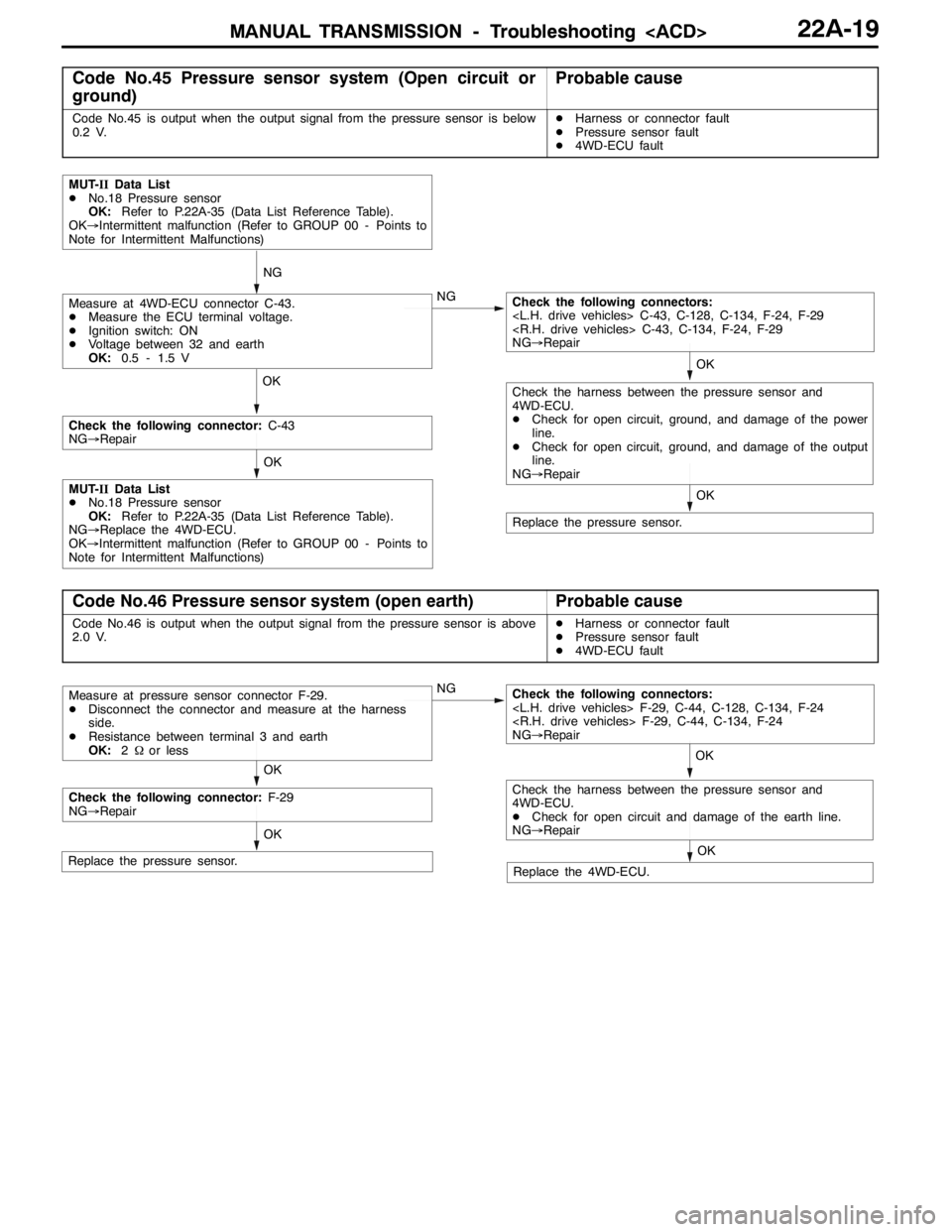
MANUAL TRANSMISSION - Troubleshooting
Code No.45 Pressure sensor system (Open circuit or
ground)Probable cause
Code No.45 is output when the output signal from the pressure sensor is below
0.2 V.DHarness or connector fault
DPressure sensor fault
D4WD-ECU fault
NG
MUT-IIData List
DNo.18 Pressure sensor
OK:Refer to P.22A-35 (Data List Reference Table).
OK→Intermittent malfunction (Refer to GROUP 00 - Points to
Note for Intermittent Malfunctions)
OK
OK NG
Check the harness between the pressure sensor and
4WD-ECU.
DCheck for open circuit, ground, and damage of the power
line.
DCheck for open circuit, ground, and damage of the output
line.
NG→Repair
OK
Replace the pressure sensor.
Measure at 4WD-ECU connector C-43.
DMeasure the ECU terminal voltage.
DIgnition switch: ON
DVoltage between 32 and earth
OK:0.5 - 1.5 VCheck the following connectors:
NG→Repair
MUT-IIData List
DNo.18 Pressure sensor
OK:Refer to P.22A-35 (Data List Reference Table).
NG→Replace the 4WD-ECU.
OK→Intermittent malfunction (Refer to GROUP 00 - Points to
Note for Intermittent Malfunctions)
OK
Check the following connector:C-43
NG→Repair
Code No.46 Pressure sensor system (open earth)Probable cause
Code No.46 is output when the output signal from the pressure sensor is above
2.0 V.DHarness or connector fault
DPressure sensor fault
D4WD-ECU fault
OKOK NG
Check the harness between the pressure sensor and
4WD-ECU.
DCheck for open circuit and damage of the earth line.
NG→Repair
OK
Replace the pressure sensor.
Measure at pressure sensor connector F-29.
DDisconnect the connector and measure at the harness
side.
DResistance between terminal 3 and earth
OK:2Ωor lessCheck the following connectors:
NG→Repair
Replace the 4WD-ECU.
OK
Check the following connector:F-29
NG→Repair
Page 828 of 1449

MANUAL TRANSMISSION - Troubleshooting
Code No.47 Pressure sensor system (Abnormal power
supply)Probable cause
Code No.47 is output when the pressure sensor power supply voltage is above
4.0V during pressure sensor power OFF or less than 4.0V during pressure
sensor power ON.DHarness or connector fault
DPressure sensor fault
D4WD-ECU fault
NG
MUT-IIData List
DNo.19 Pressure sensor power supply
OK:Approx. 5 V
OK→Intermittent malfunction (Refer to GROUP 00 - Points to
Note for Intermittent Malfunctions)
OKOK NG
Check the harness between the pressure sensor and
4WD-ECU.
DCheck for open circuit, ground and damage of the power
line.
NG→Repair
OK
Replace the pressure sensor.
Measure at 4WD-ECU connector C-43.
DMeasure the ECU terminal voltage.
DIgnition switch: ON
DVoltage between terminal 43 and earth
OK:4.9 - 5.1 VCheck the following connectors:
NG→Repair
OK
Check the following connector:C-43
NG→Repair
MUT-IIData List
DNo.19 Pressure sensor power supply
OK:Approx. 5 V
NG→Replace the 4WD-ECU.
OK→Intermittent malfunction (Refer to GROUP 00 - Points to
Note for Intermittent Malfunctions)
Page 829 of 1449
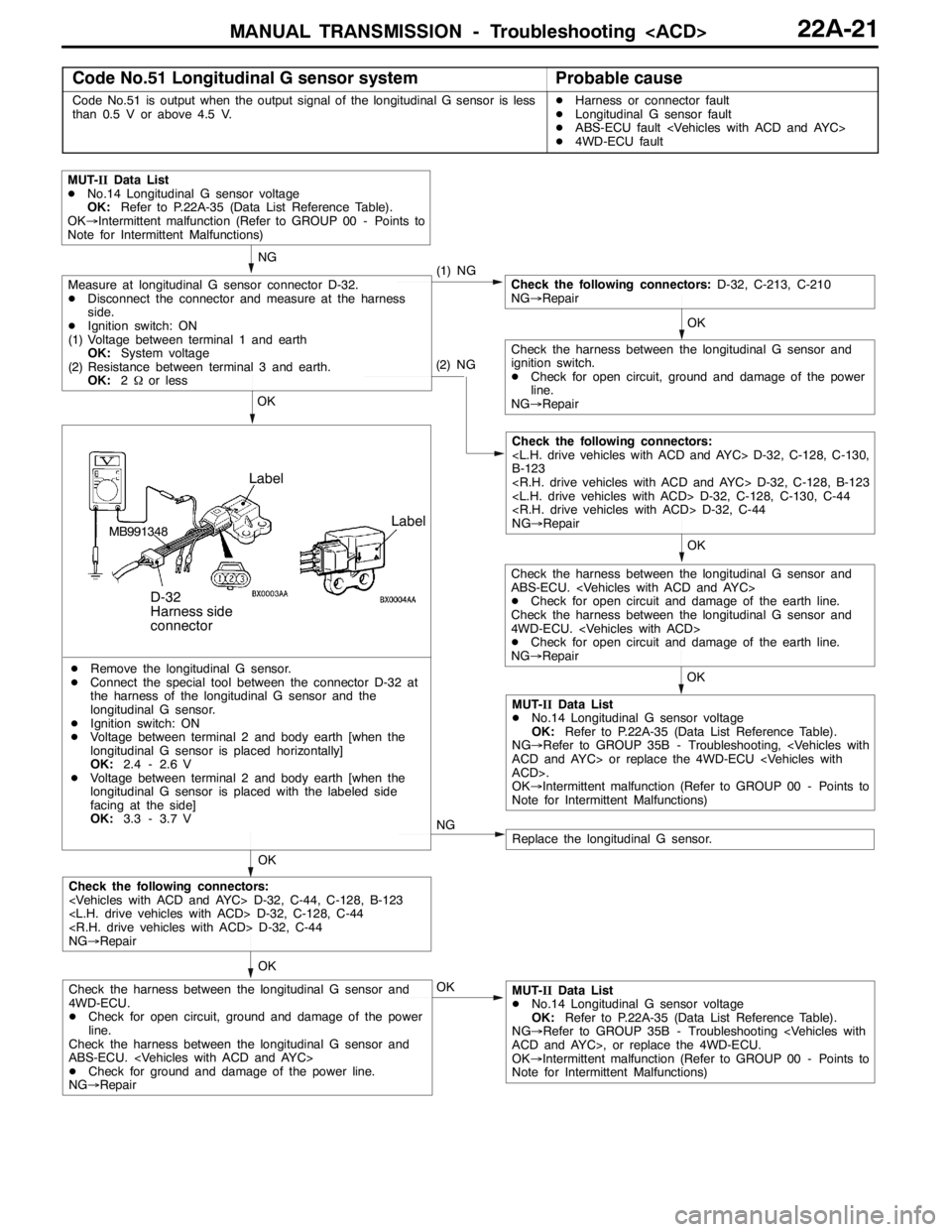
MANUAL TRANSMISSION - Troubleshooting
Code No.51 Longitudinal G sensor systemProbable cause
Code No.51 is output when the output signal of the longitudinal G sensor is less
than 0.5 V or above 4.5 V.DHarness or connector fault
DLongitudinal G sensor fault
DABS-ECU fault
D4WD-ECU fault
MB991348OK
OK
(1) NGNG
Check the following connectors:D-32, C-213, C-210
NG→Repair
MUT-IIData List
DNo.14 Longitudinal G sensor voltage
OK:Refer to P.22A-35 (Data List Reference Table).
OK→Intermittent malfunction (Refer to GROUP 00 - Points to
Note for Intermittent Malfunctions)
Check the harness between the longitudinal G sensor and
ignition switch.
DCheck for open circuit, ground and damage of the power
line.
NG→Repair
Measure at longitudinal G sensor connector D-32.
DDisconnect the connector and measure at the harness
side.
DIgnition switch: ON
(1) Voltage between terminal 1 and earth
OK:System voltage
(2) Resistance between terminal 3 and earth.
OK:2Ωor less
(2) NG
OK
Check the following connectors:
B-123
NG→Repair
OK
Check the harness between the longitudinal G sensor and
ABS-ECU.
DCheck for open circuit and damage of the earth line.
Check the harness between the longitudinal G sensor and
4WD-ECU.
DCheck for open circuit and damage of the earth line.
NG→Repair
MUT-IIData List
DNo.14 Longitudinal G sensor voltage
OK:Refer to P.22A-35 (Data List Reference Table).
NG→Refer to GROUP 35B - Troubleshooting,
OK→Intermittent malfunction (Refer to GROUP 00 - Points to
Note for Intermittent Malfunctions)
NG
DRemove the longitudinal G sensor.
DConnect the special tool between the connector D-32 at
the harness of the longitudinal G sensor and the
longitudinal G sensor.
DIgnition switch: ON
DVoltage between terminal 2 and body earth [when the
longitudinal G sensor is placed horizontally]
OK:2.4 - 2.6 V
DVoltage between terminal 2 and body earth [when the
longitudinal G sensor is placed with the labeled side
facing at the side]
OK:3.3 - 3.7 V
Label
D-32
Harness side
connector
Label
Replace the longitudinal G sensor.
OK
OK
Check the following connectors:
NG→Repair
OKMUT-IIData List
DNo.14 Longitudinal G sensor voltage
OK:Refer to P.22A-35 (Data List Reference Table).
NG→Refer to GROUP 35B - Troubleshooting
OK→Intermittent malfunction (Refer to GROUP 00 - Points to
Note for Intermittent Malfunctions)Check the harness between the longitudinal G sensor and
4WD-ECU.
DCheck for open circuit, ground and damage of the power
line.
Check the harness between the longitudinal G sensor and
ABS-ECU.
DCheck for ground and damage of the power line.
NG→Repair
Page 830 of 1449
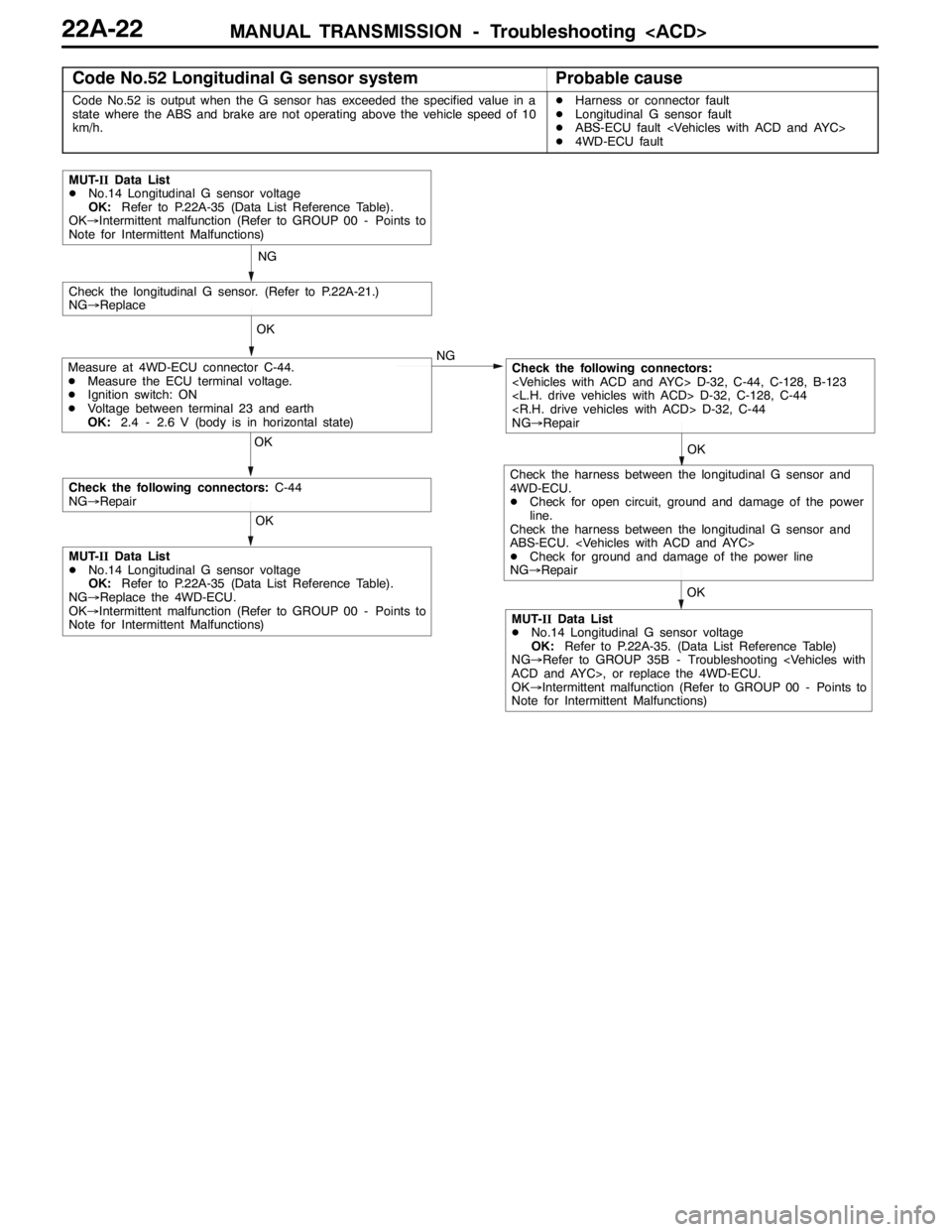
MANUAL TRANSMISSION - Troubleshooting
Code No.52 Longitudinal G sensor systemProbable cause
Code No.52 is output when the G sensor has exceeded the specified value in a
state where the ABS and brake are not operating above the vehicle speed of 10
km/h.DHarness or connector fault
DLongitudinal G sensor fault
DABS-ECU fault
D4WD-ECU fault
OK
NG
MUT-IIData List
DNo.14 Longitudinal G sensor voltage
OK:Refer to P.22A-35 (Data List Reference Table).
OK→Intermittent malfunction (Refer to GROUP 00 - Points to
Note for Intermittent Malfunctions)
OK
Check the following connectors:
NG→Repair NG
Check the longitudinal G sensor. (Refer to P.22A-21.)
NG→Replace
OK
MUT-IIData List
DNo.14 Longitudinal G sensor voltage
OK:Refer to P.22A-35. (Data List Reference Table)
NG→Refer to GROUP 35B - Troubleshooting
OK→Intermittent malfunction (Refer to GROUP 00 - Points to
Note for Intermittent Malfunctions)OK
Check the harness between the longitudinal G sensor and
4WD-ECU.
DCheck for open circuit, ground and damage of the power
line.
Check the harness between the longitudinal G sensor and
ABS-ECU.
DCheck for ground and damage of the power line
NG→Repair
Measure at 4WD-ECU connector C-44.
DMeasure the ECU terminal voltage.
DIgnition switch: ON
DVoltage between terminal 23 and earth
OK:2.4 - 2.6 V (body is in horizontal state)
OK
Check the following connectors:C-44
NG→Repair
MUT-IIData List
DNo.14 Longitudinal G sensor voltage
OK:Refer to P.22A-35 (Data List Reference Table).
NG→Replace the 4WD-ECU.
OK→Intermittent malfunction (Refer to GROUP 00 - Points to
Note for Intermittent Malfunctions)
Page 831 of 1449
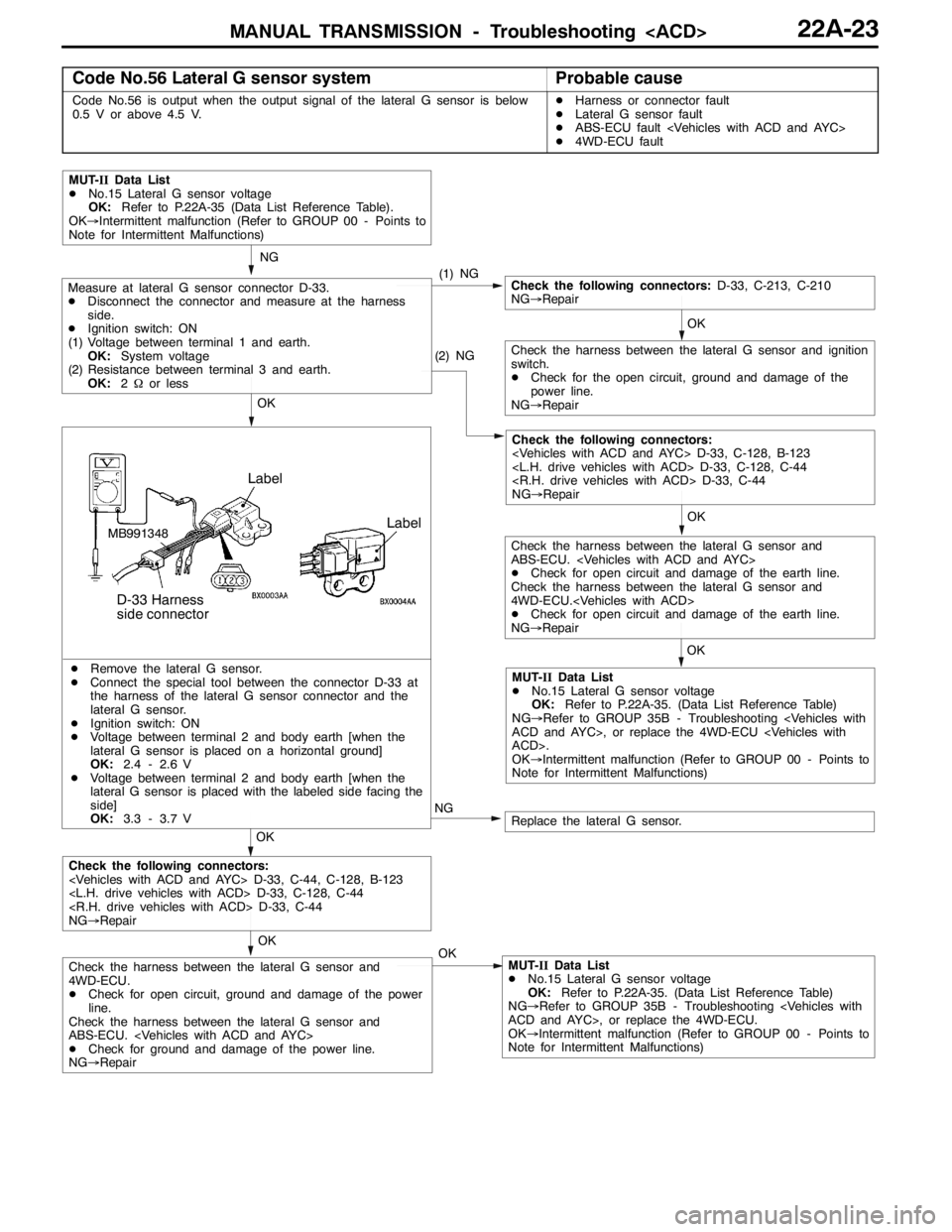
MANUAL TRANSMISSION - Troubleshooting
Code No.56 Lateral G sensor systemProbable cause
Code No.56 is output when the output signal of the lateral G sensor is below
0.5 V or above 4.5 V.DHarness or connector fault
DLateral G sensor fault
DABS-ECU fault
D4WD-ECU fault
OK
OK
(1) NG
NG
Check the following connectors:D-33, C-213, C-210
NG→Repair
MUT-IIData List
DNo.15 Lateral G sensor voltage
OK:Refer to P.22A-35 (Data List Reference Table).
OK→Intermittent malfunction (Refer to GROUP 00 - Points to
Note for Intermittent Malfunctions)
Check the harness between the lateral G sensor and ignition
switch.
DCheck for the open circuit, ground and damage of the
power line.
NG→Repair
Measure at lateral G sensor connector D-33.
DDisconnect the connector and measure at the harness
side.
DIgnition switch: ON
(1) Voltage between terminal 1 and earth.
OK:System voltage
(2) Resistance between terminal 3 and earth.
OK:2Ωor less
(2) NG
OK
Check the following connectors:
NG→Repair
OK
Check the harness between the lateral G sensor and
ABS-ECU.
DCheck for open circuit and damage of the earth line.
Check the harness between the lateral G sensor and
4WD-ECU.
DCheck for open circuit and damage of the earth line.
NG→Repair
MUT-IIData List
DNo.15 Lateral G sensor voltage
OK:Refer to P.22A-35. (Data List Reference Table)
NG→Refer to GROUP 35B - Troubleshooting
OK→Intermittent malfunction (Refer to GROUP 00 - Points to
Note for Intermittent Malfunctions)
NGDRemove the lateral G sensor.
DConnect the special tool between the connector D-33 at
the harness of the lateral G sensor connector and the
lateral G sensor.
DIgnition switch: ON
DVoltage between terminal 2 and body earth [when the
lateral G sensor is placed on a horizontal ground]
OK:2.4 - 2.6 V
DVoltage between terminal 2 and body earth [when the
lateral G sensor is placed with the labeled side facing the
side]
OK:3.3 - 3.7 V
Label
D-33 Harness
side connector
LabelMB991348
Replace the lateral G sensor.
OK
OK
Check the following connectors:
NG→Repair
OKMUT-IIData List
DNo.15 Lateral G sensor voltage
OK:Refer to P.22A-35. (Data List Reference Table)
NG→Refer to GROUP 35B - Troubleshooting
OK→Intermittent malfunction (Refer to GROUP 00 - Points to
Note for Intermittent Malfunctions)Check the harness between the lateral G sensor and
4WD-ECU.
DCheck for open circuit, ground and damage of the power
line.
Check the harness between the lateral G sensor and
ABS-ECU.
DCheck for ground and damage of the power line.
NG→Repair
Page 832 of 1449
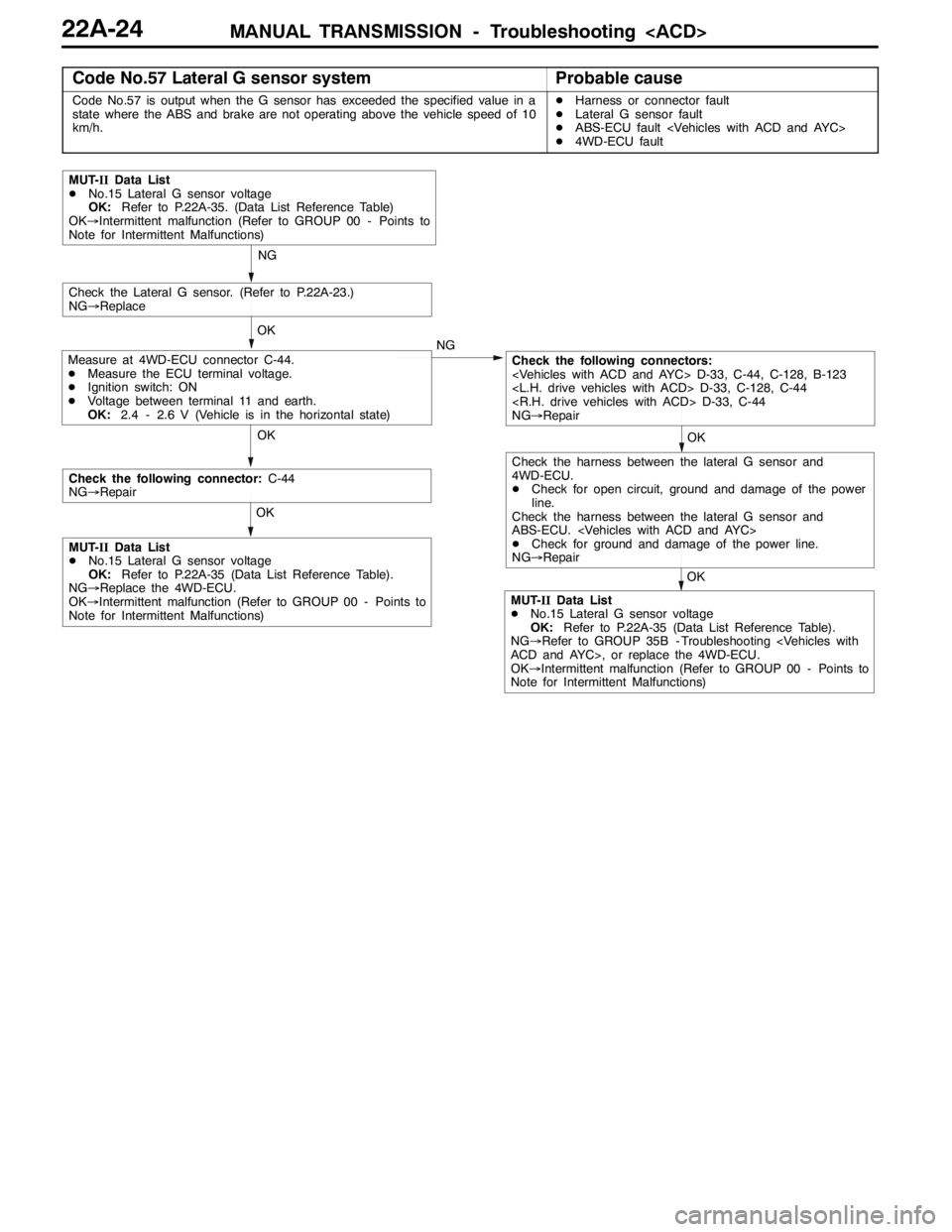
MANUAL TRANSMISSION - Troubleshooting
Code No.57 Lateral G sensor systemProbable cause
Code No.57 is output when the G sensor has exceeded the specified value in a
state where the ABS and brake are not operating above the vehicle speed of 10
km/h.DHarness or connector fault
DLateral G sensor fault
DABS-ECU fault
D4WD-ECU fault
OK
NG
MUT-IIData List
DNo.15 Lateral G sensor voltage
OK:Refer to P.22A-35. (Data List Reference Table)
OK→Intermittent malfunction (Refer to GROUP 00 - Points to
Note for Intermittent Malfunctions)
OK
Check the following connectors:
NG→Repair NG
Check the Lateral G sensor. (Refer to P.22A-23.)
NG→Replace
OK
MUT-IIData List
DNo.15 Lateral G sensor voltage
OK:Refer to P.22A-35 (Data List Reference Table).
NG→Refer to GROUP 35B - Troubleshooting
OK→Intermittent malfunction (Refer to GROUP 00 - Points to
Note for Intermittent Malfunctions)OK
Check the harness between the lateral G sensor and
4WD-ECU.
DCheck for open circuit, ground and damage of the power
line.
Check the harness between the lateral G sensor and
ABS-ECU.
DCheck for ground and damage of the power line.
NG→Repair
Measure at 4WD-ECU connector C-44.
DMeasure the ECU terminal voltage.
DIgnition switch: ON
DVoltage between terminal 11 and earth.
OK:2.4 - 2.6 V (Vehicle is in the horizontal state)
OK
Check the following connector:C-44
NG→Repair
MUT-IIData List
DNo.15 Lateral G sensor voltage
OK:Refer to P.22A-35 (Data List Reference Table).
NG→Replace the 4WD-ECU.
OK→Intermittent malfunction (Refer to GROUP 00 - Points to
Note for Intermittent Malfunctions)
Page 838 of 1449
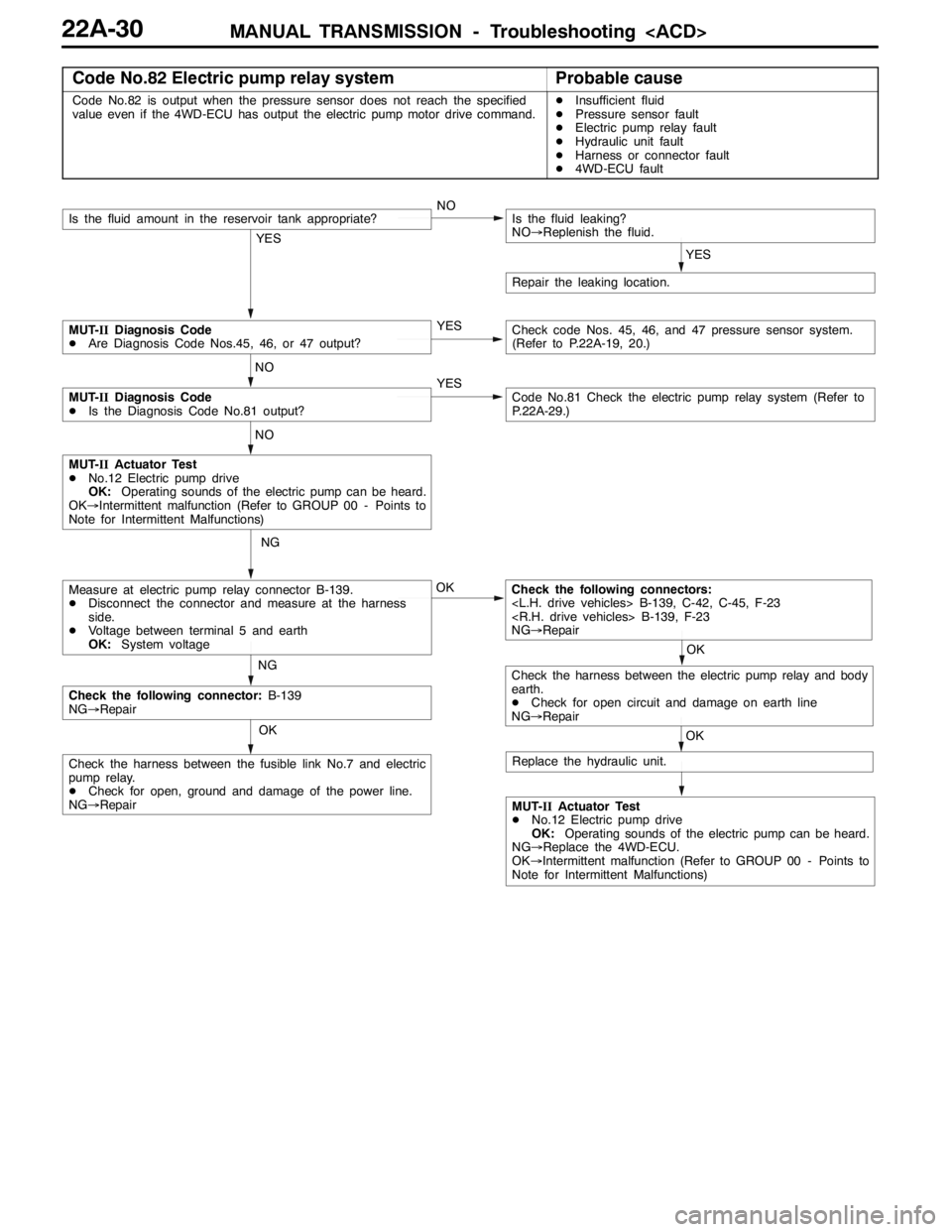
MANUAL TRANSMISSION - Troubleshooting
Code No.82 Electric pump relay systemProbable cause
Code No.82 is output when the pressure sensor does not reach the specified
value even if the 4WD-ECU has output the electric pump motor drive command.DInsufficient fluid
DPressure sensor fault
DElectric pump relay fault
DHydraulic unit fault
DHarness or connector fault
D4WD-ECU fault
OK
OK
NG
NG
MUT-IIActuator Test
DNo.12 Electric pump drive
OK:Operating sounds of the electric pump can be heard.
OK→Intermittent malfunction (Refer to GROUP 00 - Points to
Note for Intermittent Malfunctions)
Check the following connectors:
NG→Repair
OK
Check the following connector:B-139
NG→Repair
Check the harness between the fusible link No.7 and electric
pump relay.
DCheck for open, ground and damage of the power line.
NG→Repair
Measure at electric pump relay connector B-139.
DDisconnect the connector and measure at the harness
side.
DVoltage between terminal 5 and earth
OK:System voltage
MUT-IIActuator Test
DNo.12 Electric pump drive
OK:Operating sounds of the electric pump can be heard.
NG→Replace the 4WD-ECU.
OK→Intermittent malfunction (Refer to GROUP 00 - Points to
Note for Intermittent Malfunctions)
YES
NOIs the fluid amount in the reservoir tank appropriate?
YES
Is the fluid leaking?
NO→Replenish the fluid.
Repair the leaking location.
YES
NO
MUT-IIDiagnosis Code
DAre Diagnosis Code Nos.45, 46, or 47 output?Check code Nos. 45, 46, and 47 pressure sensor system.
(Refer to P.22A-19, 20.)
YESCode No.81 Check the electric pump relay system (Refer to
P.22A-29.)
NO
MUT-IIDiagnosis Code
DIs the Diagnosis Code No.81 output?
OK
Check the harness between the electric pump relay and body
earth.
DCheck for open circuit and damage on earth line
NG→Repair
Replace the hydraulic unit.
Page 843 of 1449

MANUAL TRANSMISSION - Troubleshooting
DATA LIST REFERENCE TABLE
Item
no.Check itemCheck conditionNormal conditions
01Wheel speed sensor
play and MUT-IIdis-
lth02Wheel speed sensor
py
play match.
03Wheel speed sensor
04Wheel speed sensor
05Wheel speed sensor
06Wheel speed sensor
07Wheel speed sensor
08Wheel speed sensor
09Vehicle speed
10Battery voltageIgnition switch: ONSystem voltage
11Proportional valve cur-
rent
12Proportional valve cur-
rent
13TPS voltageIgnition switch: ON
Engine: StoppedAccelerator pedal: Full
closed535 - 735 mV
Engine:Stopped
Accelerator pedal: PressGradually rises from
the above value
Accelerator pedal: Full
throttle4,500 - 5,000 mV
14Longitudinal G sensor
voltageIgnition switch: ONVehicle stopped (horizon-
tal) state2.4 - 2.6 V
g
Actual drivingThe displayed value
increases and de-
creases mainly around
2.5 V.
15Lateral G sensor volt-
ageIgnition switch: ONVehicle stopped (horizon-
tal) state2.4 - 2.6 V
g
Perform actual drivingThe displayed value
increases and de-
creases mainly around
2.5 V.
16Steering operation
angleIgnition switch: ONSteering wheel: Steer by 90
degrees to the rightR90 deg
g
Steering wheel: Steer by 90
degrees to the leftL90 deg
17Steering angle velocityIgnition switch: ONSteering wheel: No steering0 deg/sggyg
Steering wheel: SteerThe display changes
according to the revolu-
tion speed.
18Pressure sensorDuring electric pump motor operations1.0 - 1.6 MPa
Page 844 of 1449

MANUAL TRANSMISSION - Troubleshooting
Item
no.Normal conditions Check condition Check item
19Pressure sensor power
supplyIgnition switch: ONApprox.5 V
20Valve power supplyIgnition switch: ONSystem voltage
21Steering wheel sensor
voltage
are displayed alter-
nately.
22Steering wheel sensor
voltage
are displayed alter-
nately.
23Steering wheel sensor
ltSTN
Ignition switch: ONSteering wheel: Neutral1-2Vg
voltage
g
Steering wheel: Turn2.5 - 4.5 V
51Idle switchIgnition switch: ONAccelerator pedal: Full
closedON
Accelerator pedal: PressOFF
52Steering wheel sensor
STN
Ignition switch: ONsteering wheel: NeutralONg
g
Steering wheel: Turn from
the neutral positionOFF
53Steering wheel sensor
played alternaltely.
54Steering wheel sensor
played alternately
55Steering wheel sensor
learning
tral position learning exe-
cutedON
Steering wheel sensor neu-
tral position learning unex-
ecutedOFF
56Stop lamp switchIgnition switch: ONBrake pedal: DepressONppg
Engine: StoppedBrake pedal: ReleaseOFF
57Motor monitorElectric pump motor is currently operatingON
Electric pump motor is currently not operatingOFF
58Oil pressure stateElectric pump motor is currently operatingLOWp
Electric pump motor is currently not operatingHIGH
59Directional valve
Ri ht
AYC clutch right side is currently operatingON
60Directional valve
Lft
AYC clutch left side is currently operatingON
61ABS monitorABS is currently operatingON
ABS is currently not operatingOFF
62Parking brake switchIgnition switch: ONParking brake lever: PullONgg
Engine:StoppedParking brake lever: Re-
leaseOFF
63ACD mode switchIgnition switch: ONACD mode switch: PressONg
Engine:StoppedACD mode switch: ReleaseOFF
Page 845 of 1449

MANUAL TRANSMISSION - Troubleshooting
ACTUATOR TEST JUDGEMENT VALUE
Item
no.Check itemTest descriptionNormal state
01Bleeding
according to the steering angle, and operate
the Proportional valve for five minutes.Make sure no air leaks from the bleeder
screw on the transfer.
02Bleeding
according to the steering angle, and operate
the directional valve for five minutes.Make sure no air leaks from the bleeder
screw on the torque transfer differential.
03Check the oil vol-
umeOperate the directional valve to the left and
right for 20 seconds.Check that the oil volume of the reservoir
tank is appropriate.
04Electric pump
driveOperate the electric pump for 5 seconds.Operation sounds of the electric pump
can be heard.
05Check the opera-
tions of the ACDOperate the Proportional valve
supply the maximum oil pressure to the multi
plate clutch.9Generate the tight corner braking
phenomenon.
06Check clutch op-
erations
maximum oil pressure to the left clutch.When the wheels are lifted, speed
difference will occur between the rear
left and right wheels.
07Check clutch op-
erations
maximum oil pressure to the right clutch.When the wheels are lifted, speed
difference will occur between the rear
left and right wheels.
08Control OFFTurn OFF the electric pump relay, and turn
OFF the control of the ACD and AYC.In actual driving, there is difference
between control ON and OFF.
(1) The actuator test can be executed only when all the following conditions are satisfied.
DAll wheel speed sensor inputs below 20 km/h
DNo system malfunction detected
DSteering angle is within±30 degrees from the neutral position
(2) When the actuator test corresponds to one of the following conditions, forced driving will be cleared.
DWhen any one of the wheel speed sensor input is detected to be above 20 km/h (excluding
Item No.08 “Control OFF”.)
DWhen system malfunction is detected (excluding diagnostic code No.82, 84, and 85)
DWhen the forced drive time is exceeded
DWhen the MUT-IIis removed
DWhen the Clear key of the MUT-IIis operated